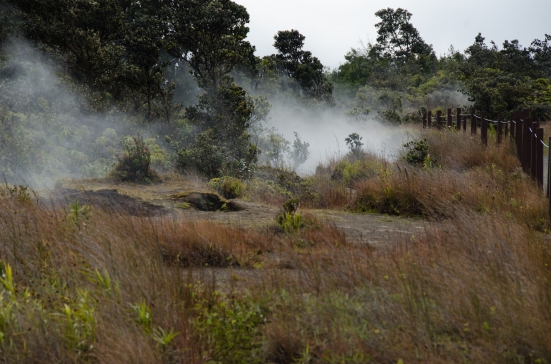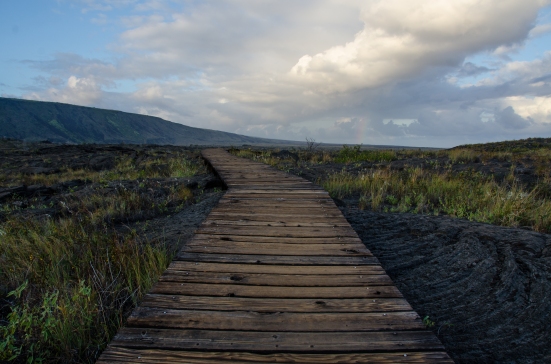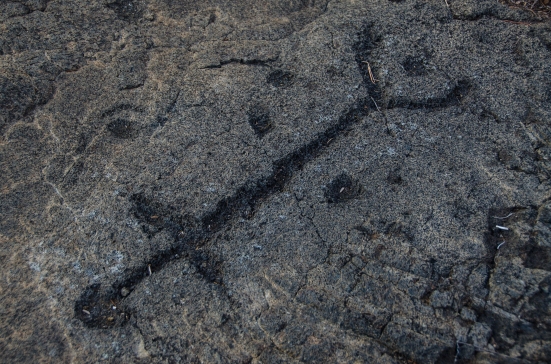As you explore the Big Island, several names keep coming up. Kamehameha the Great, the king who united the Hawaiian archipelago, and Ka’ahumanu, his formidable queen, are the island’s most dominant mortal protagonists. Among gods, two sisters lead the way: Poli’ahu, the goddess of ice and snow, and her perpetual nemesis, Pele, the goddess of fire, a pretty big deal on terrain shaped by volcanoes.
We visited Poli’ahu’s domain at the tip of Mauna Kea, the “white mountain.” From there, on a clear night, you can spot the glow of the Kilauea Volcano, home to Pele. Naturally, the Hawai’i Volcanoes National Park, the realm of fire, was our next stop.
A UNESCO World Heritage site, this park is the undisputed gem of the island. Your visit should begin at the Kilauea Visitor Center, a treasury of maps, conveniences, and advice. We then had lunch at the Volcano House next door, a historic fixture overlooking the Kilauea Caldera, the volcano’s gurgling cauldron, since the mid-1800s (the current incarnation of the hotel dates back to 1941). One anonymous visitor declared the site, “A delightful place to be if you must sit on top of a volcano.” Mark Twain stayed here and described his impressions in a chapter of Roughing It: “I have seen Vesuvius since, but it was a mere toy, a child’s volcano, a soup-kettle, compared to this.” The Caldera has quieted down since Twain’s days — we’ve observed no gurgling, and the lava lake is long crusted over — but Pele’s home is still pretty obvious: That’s the Halema’uma’u Crater fuming, a pit crater within the Caldera (think of it as a crater within a crater).

I’d love to spend a couple of days here on another visit and hike many of the spectacular trails (several begin from the Volcano House; here’s a handy day hikes brochure). For now, we had to confine ourselves to tracing the Crater Rim Drive and Chain of Craters Road, the park’s two main thoroughfares, an eventful afternoon ride. Here are some of the highlights:

Steam Vents: As the rain falls on soil heated by Kilauea, steam rises — this was an eerie view.

A better view of the Halema‘uma‘u Crater, Pele’s home, from the Jaggar Museum Overlook. The volcanology museum is fascinating in its own right, if you have the time. It is named after Thomas A. Jaggar, a prominent MIT geologist who established the Hawaiian Volcano Observatory nearby (HVO is closed to the public).
Apart from waving at Pele, I particularly enjoyed two stops along the Crater Rim Drive: The aptly named Devastation Trail and Nāhuku (Thurston Lava Tube).
The Devastation Trail begins from the picturesque Puʻu Puaʻi Overlook. Below you is the Kilauea Iki Crater (“Little Kilauea”), with Pu’u Pua’i (“Gushing Hill”) cinder cone at its heart. This was a minor dormant crater, long overlooked in the shadow of Halema’uma’u. Then it erupted in 1959, spewing the hottest lava ever measured on a volcano 1,900 feet (579 meters) into the air. Linger here and see if you can spot graceful white seabirds, their tails trailing, glide over the crater. These are koa‘e kea (white-tailed tropicbirds). They began nesting in the cliffs of Kilauea Iki after the eruption. We saw two, but they were too far and too fast for us to capture on camera. Still, here’s the setting:
 From here, the Devastation Trail is a 1-mile (1.6 km) round trip on paved road through a cinder desert left by Kilauea Iki. What a stroll!
From here, the Devastation Trail is a 1-mile (1.6 km) round trip on paved road through a cinder desert left by Kilauea Iki. What a stroll!



I first visited a site of a relatively recent volcano eruption in Arizona: the Sunset Crater Volcano National Monument and its Lava Flow Trail were memorable if unsettling experiences. That volcano erupted 900 years ago, and life was just beginning to stage a timid comeback. The quiet was deafening. Not so here. Thanks to abundant rainfall, the Devastation Trail is already being claimed by pioneer plants. And they bring birds. Look out for nēnē (endangered Hawaiian geese) and honeycreepers, tiny red and yellow flashes in ohi’a trees.

Ohi’a trees have a colorful origin story, with a Pele connection. Ohi’a was a young Big Island warrior who caught the eye of the goddess. She came to him as a beautiful maiden and asked him to be her husband. Ohi’a had to refuse — his heart belonged to Lehua, his mortal bride. Enraged, Pele turned him into a gnarled tree, the first to appear on land devastated by lava. Lehua was heartbroken. The other gods tried to help, but the best they could do was to turn Lehua into a striking red flower on Pele’s new tree. It is said that picking a lehua blossom off the ohi’a tree brings rain, as the heavens weep for separated lovers everywhere.

Just a short way off from this stark landscape is the jungle that hides the Thurston Lava Tube.

Not that you can miss it: Busloads of tourists unload at this parking lot (there are bathrooms here). It’s worth waiting for a break between the bus tours — the Tube feels claustrophobic and dull when tackled as a herd. In relative solitude, though, this is a moving experience: You walk through a dimly lit corridor cut through rock by a powerful burst of lava hundreds of years ago.

When the corridor was discovered in 1913, lava stalactites covered the roof — sadly, all gone now thanks to eager collectors. The trail through the tree fern forest and the part of the Tube open to the public is a comfortable 1/3-mile (0.5 km) walk.
Only half-a-mile away from the Thurston Lava Tube is the Kilauea Iki Overlook, another view of the Kilauea Iki Crater. The Kilauea Iki Trail begins and ends here. It cuts through the lush, primordial rain forest and scales down to the barren lava lake below, still steaming, still dangerous in places — we were later told that this 4-mile (6.4 km) loop is the most scenic hike on the Big Island. Eh, next time!
 For now, we headed down the 19-mile (30 km) Chain of Craters Road, which connects the park to the ocean. Remnants of vibrant human activity once distinguished this coastal area, but lava flows claimed much of them in the past 50 years.
For now, we headed down the 19-mile (30 km) Chain of Craters Road, which connects the park to the ocean. Remnants of vibrant human activity once distinguished this coastal area, but lava flows claimed much of them in the past 50 years.
Our main destination was the Pu’u Loa Petroglyph Trail, “the Hill of Long Life,” a 1.5-mile (2.4 km) loop to a field of 23,000 petroglyphs, the largest in Hawaii. But before you see all that — a trail of lava (an easy-to-moderate hike, NPS says):

A circular boardwalk was built to let you see the petroglyphs without damaging them. We walked along each side a couple of times — there is so much to see.

It doesn’t feel quite as momentous at first: Most carvings are pukas (or cupules), tiny circular indentations. But then you learn that each one once held a portion of a newborn’s umbilical cord, a plea for a long and prosperous life. Soon, a realization hits: You are wading through a field of hopes, centuries of hopes preserved in rock.

Humans, animals, and boats also make an appearance.


The more prominent carvings look a little discolored — they were damaged by rubbing. Don’t do it.


Truth be told, I found the Puako Petroglyph Archaeological Preserve, a hidden gem near Kona, more striking. Still, this was the first time I’ve seen so many petroglyphs in one place, and the rainbow on our way out did make my heart skip.

As darkness descended, we headed back to the Jaggar Museum Overlook, for Pele’s evening show. Mark Twain remembered it like this in Roughing It:
“… we waited until it was thoroughly dark and then started to the crater. The first glance in that direction revealed a scene of wild beauty. There was a heavy fog over the crater and it was splendidly illuminated by the glare from the fires below. The illumination was two miles wide and a mile high, perhaps; and if you ever, on a dark night and at a distance beheld the light from thirty or forty blocks of distant buildings all on fire at once, reflected strongly against over-hanging clouds, you can form a fair idea of what this looked like. A colossal column of cloud towered to a great height in the air immediately above the crater, and the outer swell of every one of its vast folds was dyed with a rich crimson luster, which was subdued to a pale rose tint in the depressions between. It glowed like a muffled torch and stretched upward to a dizzy height toward the zenith. I thought it just possible that its like had not been seen since the children of Israel wandered on their long march through the desert so many centuries ago over a path illuminated by the mysterious ‘pillar of fire.’ And I was sure that I now had a vivid conception of what the majestic ‘pillar of fire’ was like, which almost amounted to a revelation.”
Still largely accurate, I’d say:


Pele’s fireplace, Volcano House
Things to know:
- On our next visit, we will be sure to stay in the nearby village of Volcano or around Hilo, the biggest city on Hawaii’s rainy eastern side, a 40-minute drive from Volcanoes (most of the big hotels are on the dry western side, near Kona, a four-hour round trip).
- Ongoing eruptions affect road and trail accessibility. For eruption updates, check here.
- Wear layers and bring plenty of water. Prepare for frequent changes in elevation and weather.
- Read the park’s Hiking Tips — this land is unforgiving.
- We enjoyed dining at the Kilauea Lodge & Restaurant in the nearby village of Volcano, an artsy outpost, drowning in lush vegetation (it often gets chilly there). Request to sit by the International Fireplace of Friendship. A fun non-culinary fact: I was told that, in his previous life, the chef was a makeup artist on Magnum, P.I. Our food was delicious.
Read on:
- A Mauna Kea Sunset
- Hawaii’s Place of Refuge
- The King’s Golden Plover
- The Dancing Men of Puako
- Hilo’s Magic: Sacred Stones and Waterfalls
- Flying over Lava: Our No-Doors Helicopter Ride over the Big Island
Other posts about Hawaii:
- A Beach of Green Gems
- Hawaii’s Painted Church
- Turtle-spotting at Punalu’u Black Sand Beach
- Turtle Tango of Kaloko-Honokōhau
More volcanoes:
- Two Craters and Two Ruins (Arizona)

Lovely post and pics, thanks. We’ve never been to Hawaii but would like to
I hope you visit it and enjoy it. It is one of my favorite places, and I’ve only really seen one of the islands (had only one day to relax on Oahu, so Hawaii for me is the Big Island, for now). Thank you for stopping by!
I love the Ohi’a story. And, as always, your photos are lovely. I must get to Hawaii soon. I’d love to be that close to a recently active volcano.
Thank you! We loved Hawaii — I cannot wait to go back. I’d love to see the other islands, but I think we’d still go back to the Big Island as well. There is SO much to see there: many of the most important historic sites, the oldest remnants of human activity, plus the spectacular, distinct landscapes all in one place. If you go to Volcanoes, definitely give yourself a couple of days to savor it. The Kilauea Iki Trail sounds fascinating.
Very interesting post and photos! Those petroglyphs look similar to those I saw in Utah, Arizona, and Colorado.
Thank you! I haven’t seen petroglyphs anywhere else — will definitely seek them out next time we are back to the Southwest.
Most interesting. I enjoyed that very much, and the images are beautiful.
Pingback: The Dancing Men of Puako | Transplanted Tatar
Pingback: Turtle-spotting at Punalu’u Black Sand Beach | Transplanted Tatar
Pingback: A Mauna Kea Sunset | Transplanted Tatar
Pingback: Flying over Lava: Our No-Doors Helicopter Ride over the Big Island | Transplanted Tatar